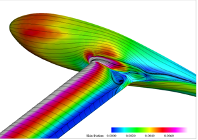
The article concerning the shape optimization study based on RBF Morph mesh morphing presented at 30th International CAE Conference that took place in October on 27th and 28th in Pacengo del Garda – Verona can be downloaded in the Presentations and Proceedings 2014 or by means of the link.
Abstract “RBF-based aerodynamic optimization of an industrial glider”
The present paper is addressed to the improvement of the aerodynamic design of an industrial glider flying at Mach 0.08.
The original design exhibits performance affecting separation occurring in the wing-fuselage junction region at high incidence angles.
Adopting a numerical optimization approach affordable in the case that HPC resources are limited, the separation was significantly reduced updating the local geometry of fuselage and fairing maintaining the wing airfoil unchanged.
Shape variations were applied to the glider’s baseline configuration through a mesh morphing technique founded on the mathematical framework of radial basis functions (RBFs).
The computational outputs were obtained employing a combined use of ANSYS® DesignXplorer™, ANSYS® Fluent® and RBF Morph™ software working in the ANSYS® Workbench™ environment.
The k-ω SST turbulence model was used with two levels of structured hexahedral meshes, both generated using ANSYS® ICEM CFD™: a coarse grid to be used applying wall functions and a fine version with cells clustering aimed to solve the boundary layer up to the wall.
Two shape modifiers were set up by means of RBF Morph™ to drive shape morphing guaranteeing, at the same time, the fulfilment of the manufacturing constraints.
Once the RBF solutions were computed and made available, a DoE optimization calculation was set up using ANSYS® DesignXplorer™ and, after performing CFD runs through ANSYS® Fluent®, the potential optimal candidates maximizing the aerodynamic efficiency were identified by means of the response surface approach.
A relevant aerodynamic efficiency improvement was finally gained moulding the glider’s geometry according to the selected optimal design point.
Such an optimization study is part of an explorative set of analyses that focused on better addressing the numerical strategies to be employed in the development of the EU FP7 Project RBF4AERO.



